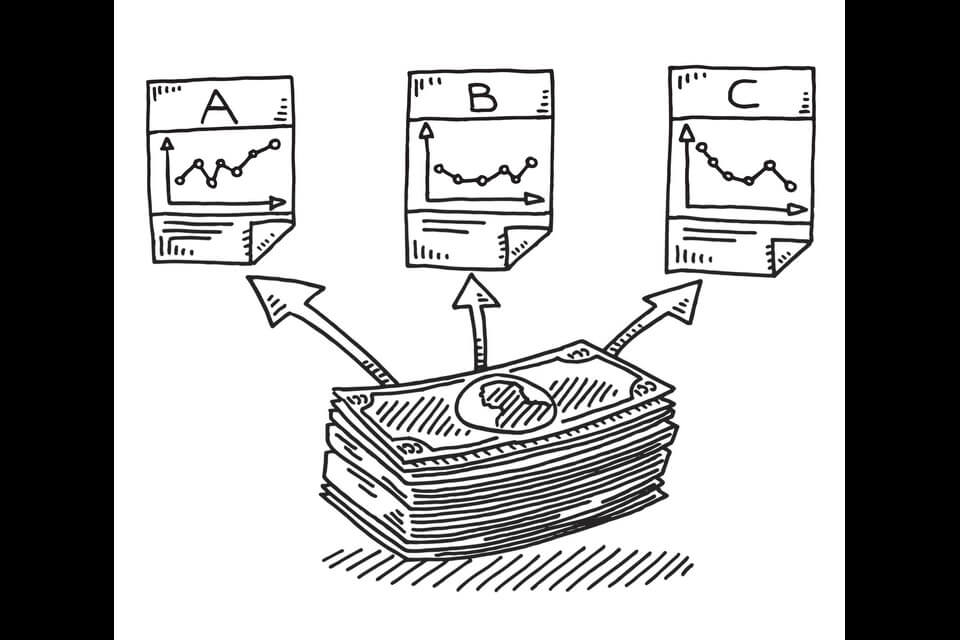- Introduction
- The Importance of Diversification in Your Portfolio
- Key Considerations for Income-Oriented Investors
- Dividend Growth Stocks: Building Sustainable Income Over Time
- High-Yield Stocks: Maximizing Current Income Generation
- Balancing Dividend Growth and High-Yield Stocks: Finding the Right Mix
- Long-Term Outlook and Considerations
- Frequently Asked Questions (FAQs)
- Conclusion
Introduction
When it comes to stock investing, many people often feel unsure about choosing between two main options: dividend growth or high-yield stocks. First of all, this choice is very important and can affect your financial future in a big way. So, it’s key to understand how each one works. Then, by learning more and using smart strategies, you can build a strong, steady income portfolio that fits your personal goals and needs.
The Importance of Diversification in Your Portfolio
Portfolio diversification strategies are key to building a strong investment plan. To begin with, let’s look at what portfolio diversification means. It simply means spreading your money across different types of investments to lower risk. So, while dividend growth and high-yield stocks are important, you should also add things like bonds, real estate, and more. This way, if one investment does badly, others can still do well. As a result, your whole portfolio stays safer.
In short, diversification helps protect you from big market changes. That’s why, as people always say, “Don’t put all your eggs in one basket.”

Key Considerations for Income-Oriented Investors
Investors who seek income-oriented portfolios have specific financial goals, often centred around establishing a reliable stream of cash flow to support their current and future financial needs. To effectively achieve this objective, consider the following income-oriented investment tips:
Choose Assets that Generate Income Regularly
When building an income-focused portfolio, it is very important to choose different asset classes that give steady income. For example, you can pick dividend-paying stocks, bonds, or even CDs that earn interest. Also, these investments pay on a set schedule. So, regular income helps you cover everyday costs. In the end, this gives you more financial safety and peace of mind.
Focus on Assets that Provide Consistent Returns
Consistency is very important when you want steady income. So, you should look for investments that have a strong history of giving regular income. For example, dividend growth stocks and bonds from safe, stable companies often give reliable returns. Also, this kind of steady income is very helpful. In fact, it matters most for people who depend on their investments to pay for living costs. Therefore, choosing wisely really makes a difference.
Diversify Across Various Income-Generating Investments
Diversification is a very important way to manage risk in an income-focused portfolio. So, it is smart to spread your money across many types of assets. For example, you can invest in stocks, bonds, real estate, and even alternative investments. Also, by doing this, you lower the chance of big losses. Even more, if one investment does badly, others may still do well. That way, your income stays steady and strong.
Set Realistic Income Goals Based on Your Financial Needs
First, define how much income you need based on your current situation and future goals. It’s important to be realistic about how much money you need to cover things like daily expenses, bills, and any big goals, such as saving for retirement or education. Then, your investment strategy should match these income needs. This way, your investments can help you meet both your present and future financial goals.
Reinvest Income to Benefit From Compounding Returns
One of the best ways for income-focused investors to grow their wealth is by reinvesting the income they earn. This is especially useful for those who want steady income with dividend growth. By reinvesting your dividends or interest, you can increase your returns a lot over time. In fact, thanks to compounding, your money can grow faster. So, reinvesting is a powerful strategy to boost your investment success.
Dividend Growth Stocks: Building Sustainable Income Over Time
The great thing about investing in dividend-paying stocks is how dividend growth and compounding gains work together. First of all, when companies raise their dividend payouts, your income also goes up. Then, when you reinvest those dividends, your money grows even faster. Over time, this can really help you build wealth. So, the longer you hold these investments, the bigger the compounding effect becomes.
Also, a smart and popular strategy is to focus on sustainable income through dividend growth. This is very helpful for people who want steady and growing income. In this case, the goal is to invest in companies that regularly increase their dividends. Usually, these companies are strong, well-known, and financially stable. Because of that, they are great choices for long-term investors.
In addition, the power of compounding is what makes this strategy work so well. As companies keep growing their dividend payments, your income keeps going up too. And if you keep reinvesting those dividends, your gains keep growing even more. So, the longer you stick with it, the more money you can make. That’s why many smart investors love this approach.
The Advantages of Sustainable Income with Dividend Growth Include:
Steady Income Growth: First of all, companies that grow their dividends usually increase payouts every year. As a result, your income keeps rising over time. This is very helpful because it protects your buying power against inflation. Also, these companies are often known as blue-chip stocks or large-caps stocks. So, many smart investors choose them first.
Financial Stability: Also, investing in these companies means you are choosing strong, well-known businesses. Most of the time, they have solid financial health. Because of this, they can add more safety to your portfolio.
Long-Term Wealth Building: Finally, by holding these stocks for a long time, you can earn more income and also enjoy price growth. So, they help build wealth in two ways.

High-Yield Stocks: Maximizing Current Income Generation
For investors who require immediate income, maximizing current income with high-yield stocks is a strategy worth considering. High-yield stocks, often referred to as income stocks, are known for their relatively higher dividend yields. These stocks typically offer a more substantial stream of current income compared to other investment options.
The Key Points to Understand About this Strategy Include:
High Current Income: First of all, high-yield stocks pay a large part of their return through dividends. So, this is great for investors who need income now to help cover living costs or who don’t plan to invest for a long time.
Risk Considerations: However, these stocks can go up and down more with the market and economy. Therefore, it’s very important to think about how much risk you can take and how long you want to invest.
Immediate Cash Flow: Also, high-yield stocks can give you quick income. This is helpful for retirees or anyone needing steady cash. Most of the time, they pay monthly or quarterly.
Diversification: Finally, while these stocks are useful, don’t put all your money in them. Always diversify to stay safe.

Balancing Dividend Growth and High-Yield Stocks: Finding the Right Mix
The million-dollar question is, how do you find the optimal investment mix between dividend growth or high-yield stocks? The answer lies in your financial goals and risk tolerance. A balanced approach can involve a combination of both to secure immediate income while building wealth for the future. Let’s take a deeper look at both of them.
Key Strategies for Balancing Dividend Growth and High-Yield Stocks
Finding the right balance can be achieved by allocating a portion of your portfolio to dividend-growth stocks, which offer long-term growth potential, and another portion to high-yield stocks, which provide immediate income. The specific allocation should be based on your income needs and investment horizon.
The Risk-Return Trade-Offs in Different Portfolio Compositions
Understanding the risk-return trade-offs is essential. Dividend growth stocks may offer lower initial yields but come with the potential for capital appreciation, while high-yield stocks deliver immediate income but might carry higher volatility. Assess the level of risk you are willing to tolerate and align it with your portfolio composition.
Insights into Constructing a Diversified Income Portfolio
Portfolio diversification is key to managing risk. Besides dividend growth and high-yield stocks, consider incorporating other income-generating assets such as bonds, real estate, and dividend-focused exchange-traded funds (ETFs) to diversify your income sources further.
Guidance on Finding the Right Mix Based on Individual Goals
Your investment mix should be tailored to your specific financial objectives, whether it’s supplementing your current income, saving for retirement, or generating wealth over time. By understanding your unique goals, you can determine the most suitable mix of dividend growth and high-yield stocks to align with your vision.
A well-balanced approach in this context can provide immediate income to meet your current financial needs while nurturing the potential for long-term wealth accumulation, offering you the best of both worlds. Every stock investor needs to understand that there’s no one-size-fits-all solution

Long-Term Outlook and Considerations
The value of having a long-term view in your investment plan is very important. In fact, it is one of the most important parts of financial success. A long-term view helps your portfolio stay strong, even when markets keep changing.
Why a long-term outlook matters: First of all, long-term investing means you keep your focus on your goals, even when the market goes up and down. So, by thinking about the future, you can stay calm during short-term changes.
How market conditions affect income investments: Also, market conditions always change. These changes can affect your income investments in different ways. Because of that, it’s important to understand how your income may change. Then, you can make smart updates to your portfolio when needed.
Tips for reviewing your portfolio: In addition, checking your portfolio often is a must. You may need to rebalance it, review how each investment is doing, and make small or big changes over time.
Think about inflation, taxes, and your goals: Over many years, inflation can reduce the value of your money. So, choose investments that grow faster than inflation. Also, always know how taxes affect your income. And don’t forget—your financial goals may change, so your plan should change too.
In the end, thinking long-term gives you the strength and patience to reach success.
Frequently Asked Questions (FAQs)
1. Are there any tax benefits associated with investing in dividend-growth stocks or high-yield stocks?
Yes, there are tax advantages to both types of stocks. Dividend growth stocks often benefit from lower tax rates on qualified dividends, while high-yield stocks may have a portion of their income classified as qualified dividends. Consult a tax professional for personalized advice.
2. How do high-yield stocks differ from dividend-growth stocks?
High-yield stocks provide a higher current income through substantial dividend yields. They may be more sensitive to market fluctuations and economic conditions.
3. What percentage of my portfolio should I allocate to dividend growth stocks and high-yield stocks for optimal results?
The ideal allocation depends on your financial goals and risk tolerance. A balanced approach might involve a mix such as 60% dividend growth and 40% high yield, but your circumstances should determine the precise ratio.
4. What are some alternative income-generating investments beyond stocks?
Consider bonds, real estate investment trusts (REITs), and annuities as potential options.
5. How can I ensure the safety of my investments while seeking income?
Diversify your portfolio across different asset classes and income sources. Regularly review and adjust your portfolio based on your financial goals and risk tolerance.
Conclusion
As we reach the end of this simple guide to understanding your portfolio needs, one thing is clear. Choosing between dividend growth and high-yield stocks is not the same for everyone. First of all, your choice should depend on your goals, how much risk you can take, and how long you plan to invest.
Also, by learning how to mix both types of stocks, understanding the risk-return dynamics, and building a balanced income portfolio, you can create a plan that fits you. So, a mix can give you steady income now and help grow your wealth later. That way, you get the best of both worlds.
Finally, always remember—your investment journey is personal. Choose what works best for you. With the right mix, you can move toward the future you want.



